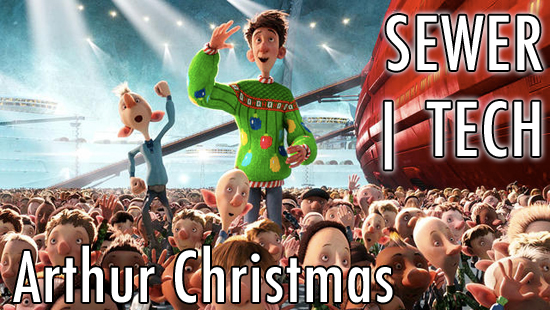
Doug Ikeler is a veteran of the special effects world that has hopped back forth from animation to live-action over and over, working on films like The Matrix Revolutions, Babe, and Open Season. He’s the kind of guy that doesn’t have a monstrous list of credits because he gets involved with large-scale projects in a first-in/last-out manner that sees him dedicating years and years to individual projects. On Arthur Christmas, the first CGI-styled animation from the studio in partnership with Sony Pictures Animation, he took on the role of “Visual Effects Supervisor” which, as you’ll soon see, brought with it a ton of challenges.
I was fortunate enough to speak with Mr. Ikeler for a few minutes, with the arrangement having been made by a PR group that focuses on science and technology in the movies, and bringing audiences closer to that aspect of blockbuster films. (Previously they arranged for me to speak with a Primatologist about Rise of the Planet of the Apes, and I foresee many more cool interviews in this vein.)
In any event, since the idea was for this to be a tech-focused interview, I decided to let loose and ask the questions about technological approach, division of labor, and workflow that interest me about CGI animation. Because of that, the conversation gets a little technical at points, as Doug lets loose with the shop-talk. Don’t get me wrong: this isn’t a dry interview filled with impenetrable jargon, but simply a more technically-minded conversation than you might typically see in a promo interview. While I’m no animation expect, I did toss in a footnote or three where I felt some terms or ideas might need a little context for most readers. You should have fun with the interview and hopefully learn something! Wrapping my head around the computing and scale of detail that goes into these kinds of films always boggles my mind, but Doug definitely has a handle on it…
+++++++++++++++
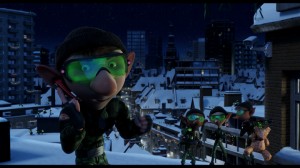 Renn: Starting out, tell me a little bit about what your “Visual Effects Supervisor” position on Arthur Christmas meant, in terms of your day-to-day labors…
Renn: Starting out, tell me a little bit about what your “Visual Effects Supervisor” position on Arthur Christmas meant, in terms of your day-to-day labors…
Doug: The easiest ways to summarize it is to say I creatively supervised digital production. So day-to-day it’s approving all imageries coming out of lighting, effects, cloth & hair, as well as day-to-day organizing of the teams, which includes CG supervisors and each of their groups, to kind of figuring out where we’re going to put our efforts, and giving them direction, I suppose.
Renn: You’ve also worked extensively on live-action features, so aside from the obvious differences, what in your mindset do you have to change between working in the two mediums, and how does that change what you do?
Doug: There’s notable differences obviously– I’d categorize it in two ways: We’re obviously creating everything from scratch, so we’re far more asset driven, we’re trying to get out ahead of the process by building environments in which they can do all their shooting. Obviously we’re trying to get our characters made from a looks stand-point as well as a rigging and performance standpoint.* So the real difference is that we’re “running wide,” compared to a live-action production. We’re doing a lot of things at the same time, but with a little bit slower, methodical approach because once we go into shot production–once animators start animating shots, start lighting shots–that’s when we pull off the brakes and let everything run. But up to that point we’re really trying to just get each asset approved for look, approved for performance, and approved for technical usability.
That’s a little different from live-action, which is a little more hand-to-mouth, you know? You work on one shot until it’s done and then you move on to the next one, but [in animation] we’re working in parallel with not only the shots, but also the assets that are all coming up at the same time. And then you’re trying to intergrate them with each other: if they’re characters or environments they all need to look alike and have similar abilities once you get into shooting your shots.
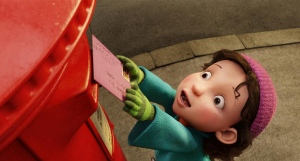 Renn: So in a format like this wherein you get nothign for free, every pixel is added from scratch, how do you determine what falls under your specific purview as the “visual effects supervisor” vs a general animation supervisor or something like that?
Renn: So in a format like this wherein you get nothign for free, every pixel is added from scratch, how do you determine what falls under your specific purview as the “visual effects supervisor” vs a general animation supervisor or something like that?
Doug: Right, well… you know… it’s different on every movie. You really weigh your players and figure out where your strengths and your weaknesses lie and where your attention needs to go. For the most part, I’m there early on with the director–I’ve been on the film four and a half years–so, the first stage of the production is visual development and at that point you’re sitting with [director Sarah Smith], you’re sitting with the art department and you’re working through, “what can we get done for this budget? What makes the most sense to put into this film that has to be built from scratch?” You’re also listening for an appetite- what the director wants, what the art department is hearing that your director wants. You’re kind of a liason at that point, which is just saying, “well sure, that fits within the scope of what we could build with this amount of money we plan to spend,” and things like that. During visual development you’re also trying to say “these things will go better if you do them like that,” and trying to lead the creative aspect to something that’s more producable and more fruitful, stuff that will continue to give.
After you move out of that visual devleopment stage, then you’re moving into the pre-production stage where you’re trying to build each of the assets, and at that point my job is really just making sure I’m getting what I need out of the art department, and that I’m taking the visuals to the point where I’m making the director happy. So I’m typically spending every single day, every hour with the assets and then one day a week I’m showing to her. So it’s just about wrangling everything and making sure it’s on-schedule, on-time and hitting the creative mark.
Renn: The things in a live-action film that inflate a production budget tend to be pretty obvious: explosions, large-scale sets, that kind of thing, but what are the kinds of thing that drive up a CGI animation budget?
Doug: That’s actually very easy, because this project pushed all of them. The obvious thing is character count, right off the top. The more unique characters you have, the more unique rigs, the more unique look-devs [look developments: the process of designing a character/location/prop], the more hair, cloth, all of that… It’s just a geometric function: you add a character, you add five new steps. The next obvious one is the number of locations and complexity of locations, which this movie really pushed on. The things you can say first are; your look-dev and creation of an interior of a room is much easier than creating a city, and we had a lot of exterior environments, a lot of cities. We had North Pole, the Serengeti, we had an island in Cuba, we had three other villages, and another city I didn’t mention. So we had really large-scale sets, not to mention the bedrooms and all the Claus residents and things like that.
So that one right there… you sit down early with the director and you say, “okay, we’ve got a budget for fifteen unique sets and probably five ancillary sets.” In the case of this film you could just tell early on the desire–because it’a a road picture and is about getting around the world in one night–we were looking at thirty-five unique, large-scale sets, not to mention small one-off bedrooms and things like that. So we just had to be really creative, is the bottom line. We had to figure out ways to get a lot of mileage out of as much geometry as we could afford to build, as well as try and be smart about where we placed our cameras and not over-build.
Those are the two that will catch you off guard. Seriously, adding two sets can be adding ten percent to your look-dev and construction build.
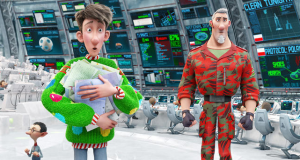 Renn: So maybe not all that different from live-action after all?
Renn: So maybe not all that different from live-action after all?
Doug: Ha ha, yeah, exactly. It’s not that far off. I mean, the thing with live-action is the scale of the set has some implication on the price, but near as much as in CG. Because with this for example, we had to build Toronto. And you know Toronto is only believable when you get down to the street and see normal things like post-boxes and bus-stops and recycle bins, things like that. It’s going to be more expensive to shoot in Toronto, but you’re going to get the small-level detail for free. We don’t. The onus is on us to continue to add that detail until it become believable.
Renn: Often with CGI animations like this the conversation or hype will come up around it that it took on some particular animation challenge, be it X movie redefining how water is done, or Y movie taking on hair in a new way. Is there any such development that came from Arthur Christmas?
Doug: You know, on that question I’m always just going to go back to scale, because we had to do the whole world. But really, the number of sets, the number of characters and crowds, we did a lot of large-scale effects like oceans, footprints in snow and sand, we did scultping of clouds… There’s a shot where Grand Santa takes a cloud and shapes it into a snowman. We had truly volumetric clouds**, so we had a lot of sequences where you’re flying through the clouds and that’s hard all by itself. You’re not really going to find anything in there you haven’t seen before, it’s just the complexity and the level of detail and scale that we had to put in it. And you can find them- we had massive crowds, literally thirty-thousand elves in one shot. We had a full-scale ocean with wave simulation on a beach. All of those are hard all by themselves is all I’m trying to say, and we really took on many of them all at the same time.
Renn: With this particular film, which is kind of rooted in a aesthetic tradition, were you required to change how you worked and designed at all? Did you draw lines where certain things would not fit in an Aardman movie?
Doug: Oh absolutely. We knew we weren’t going to make this stop-motion looking like Flushed Away did- it wasn’t going to be CG that looked like stop-motion, and there was going to be nothing that looked stop-motion about it. But there was a lot of pressure and a lot of desire to have this be a unique look for Aardman, given this is kind of their first “CG look” that they’ve gone for. So we wanted to be influenced and be inpsired by things that we’ve seen in their stop-motion work, but we weren’t going to be using that as the style. You can see it very clearly in the character design– the characters are all not quite perfect, they’re not “pretty” characters like you might find in a Disney film, they’re just a little bit off but still charming at the same time. That was really important to us and we put a lot of effort into… we’ve got a couple of texturing layers that all they do is take the smoothness off the surface so it doesn’t shade spherically. And then at Model time we’re working really hard, only working on half the character and then when it came to the symmetry of the character, another phase was put it in to take symmetry off as much as possible, so everything didn’t seem just quite perfect.
When you look at an Aardman film, when you look at a stop-motion set, there’s a very tactile nature to everything, you feel like you can touch everything, and that’s really due to the fact that it’s miniatures, and so all the scales and the textures are exaggerated, even though in the real world the set is small. We didn’t scale up textures, but we definitely wanted you to feel them more than you would in most CG films, so we textured strong, we textured confidently, and again, a lot of effort was put into making sure things we’re not perfect, but had a comfortable feel at the same time.
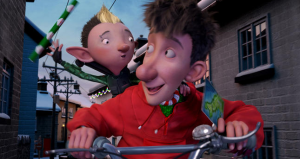 Renn: You mention one of the biggest problems in animation being scale, and why this question treads dangerously close to be too tecchnical, I was curious if you thought there were any trends of technology or automation that might mitigate that and allow animation to keep expanding in scale, or if a certain curve of effort will always be there.
Renn: You mention one of the biggest problems in animation being scale, and why this question treads dangerously close to be too tecchnical, I was curious if you thought there were any trends of technology or automation that might mitigate that and allow animation to keep expanding in scale, or if a certain curve of effort will always be there.
Doug: You know, I don’t expect so. I expect things will continue to- appetites are only going to continue to grow, and computers are only going to get faster. The rate at which processor speeds have increased over time, versus the demand of the films… it hasn’t been the same rate. So we actually have been getting more processor speed, quicker than we have been asking for new things, I feel. Not to mention we’ve moved into 64-bit operating systems, so we’re actually able to build much heavier and rely on memory much more than we ever could before, so our sets are getting big (and we had really big sets). Here at Imageworks we ray-trace our products***, so you know, ray-tracers are hungry. We’re doing lots of ray-bounces- we have lots of ice in the movie, so we’re fully taking advantage of refracted rays, reflected rays, as well as sub-surface qualities that ice has. All of those are things that add to the level of scale and believability in the movie, so I expect we’re going to keep pushing it and I expect we’re going to keep moving faster.
I think the real place the industry is going to change, in my opinion, is we’re going to want to see more, sooner. Right now you take a lot of leaps of faith- you build a model and you’re seeing it in a T-pose, you’re not seeing them posed. We’re now offering the director, when they first see a character they are in a T-pose as well as what we would consider a “generic” pose that we pulled from an animator. When it gets to layout, once they get in they’re looking at a really rough set, rough geometry, not much lighting, not much texturing, and camera work is kind of one of those things… you let the layout artist work for a while and you come back and the director gives notes. But all of that is going to become more fluid. I expect you’ll see a lot more pre-viz type layout set-ups where you can see texturing and lighting, at least a first pass. I expect the rigs to start becoming more light-weight and interactive so the director can almost “shoot” their shot. We’ll probably also use motion capture- I know people are doing this already, but I expect more of it. We’ll use motion capture to get the first pass of animation so in layout you’re starting to see a semblance of animation. All of that just to more get what you get in live-action, which is the ability to look through a camera and get a feel for your shot before you hit go, and we’ve never really been able to do that. We’ve always had to lots of little, “I know it’s going to look this way, but that block character is going to move over there and when we get into animation we’ll actually animate into that camera, and then you’ll have to wait until lighting and texturing before you see what that look like.”
I think you get the picture.
+++++++++++++++
I think we do, and I for damn sure now know why I’m not a CGI artist, but am happy there are enough of them out there to make this stuff happen! Thanks to Doug for his time, and remember that Arthur Christmas is entering the family film fracas and opening TODAY for Thanksgiving…
Twitter
Comment Below
Message Board
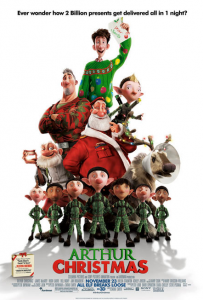 *Remember that CGI animation is not like hand-drawn, where each shot represents an individual drawing with its own perspective of the scene. Instead, sets are built digitally, characters added and animated, virtual lights programmed in, and then virtual cameras are brought in to “shoot” the scene much as you would in real life.
*Remember that CGI animation is not like hand-drawn, where each shot represents an individual drawing with its own perspective of the scene. Instead, sets are built digitally, characters added and animated, virtual lights programmed in, and then virtual cameras are brought in to “shoot” the scene much as you would in real life.
Also: “rigging” refers to the adding of a digital skeleton inside each character, which allows them to be articulated and made to move by animators.
** Each cloud was programmed into the computer as a fully fluffy 3D object, rather than flat cloud layers that were composited in over the 3D scenes.
*** Ray-tracing are programs/systems used in CGI to simulate the path of a photon of light around and through a group of objects, and is a key component of the more photorealistic CGI often seen in photography and increasingly in live-action films.